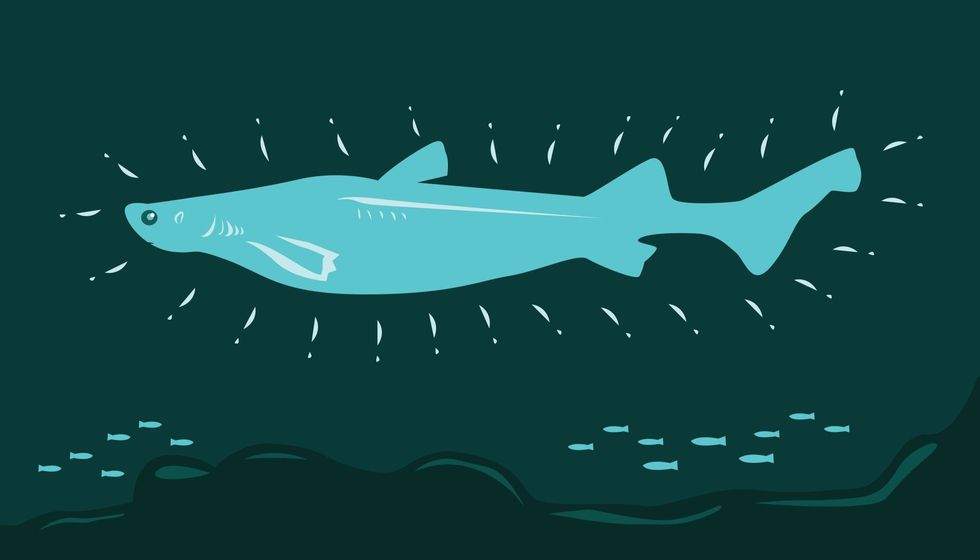How fascinating it is to uncover the unexplored creatures of an ocean! In this Kidadl article, we shall be exploring and discussing the kitefin shark which belongs to the Dalatiidae family.
The kitefin shark (Dalatias licha) is a powerful predator of the deep ocean. It can be commonly found at a depth of 660–1970 ft (200-600 m).
It is known to be the biggest vertebrate that emits bioluminescence. It has a cigar-shaped body that is around 3.3-5.2 ft (1-1.6 m) long. It has two dorsal fins and the first one is devoid of spines.
Its specially designed caudal fin gives it the power to pierce through the water at a good pace while preying on some creature. It has a wide habitat range that covers almost all the tropical and warm temperate waters.
If you enjoyed this snipper, keep reading for lots of interesting and funny kitefin facts coming your way. And if you are someone who enjoys reading fish facts then check out our skipjack tuna facts and lake trout facts pages.
Dalatiidae Interesting Facts
What type of animal is a Dalatiidae?
Dalatiidae is the family of the kitefin shark. Kitefin sharks can be found in coastal areas all over the world.
What class of animal does a Dalatiidae belong to?
The kitefin shark belongs to the class Chondrichthyes, order Squaliformes, family Dalatiidae, and genus Dalatias. The scientific name of this Dalatiidae species is Dalatias licha.
How many Dalatiidae are there in the world?
Kitefin sharks from the Dalatiidae family can be found almost all over the world. Still, the conservation status of this fish species is Vulnerable. Their exact population count is not yet recorded.
Where does a Dalatiidae live?
Kitefin sharks (Dalatias licha) have a wide habitat range. They can be found in the tropical waters and also the subtropical and temperate waters as well. Their habitat range is scattered among all the oceans.
In the Atlantic Ocean, these sharks can be found in the Georges Bank and in the Gulf of Mexico, and near Brazil also. In the Indian Ocean, these shark species can be found near South Africa and Mozambique. And in the Pacific Ocean, these species occur near Japan, Java, Australia, and New Zealand.
What is a Dalatiidae's habitat?
The Dalatiidae species can be found in the tropical and warm temperate waters all over the world. These small sharks inhabit the coastal region of the continents and can be found near the ocean bed.
Who do Dalatiidae live with?
Kitefin shark species are naturally seen to lead a solitary lifestyle. However, sometimes, they can be seen in small groups near the ocean bed.
How long does a Dalatiidae live?
Kitefin shark species from the Dalatias genus have a maximum lifespan of 17-18 years.
How do they reproduce?
Kitefin sharks are viviparous in nature which means they give birth to living babies like mammals instead of laying eggs that hatch and give rise to a baby. They have no definite breeding season as they can breed at any time of the year.
But it is recorded that most breeding activity occurs in the spring and during the fall. The litter size may vary from 10-16 depending on the size of the female. The gestation period in these sharks is found to be around two years.
What is their conservation status?
According to the IUCN Red List, kitefin shark species are categorized under the conservation status of Vulnerable species.
Dalatiidae Fun Facts
What do Dalatiidae look like?
Kitefin sharks from the Dalatiidae family are big marine fish who have cigar-shaped bodies. These sharks have a unique body structure.
These sharks have some amazing teeth in their month. In the upper part of their jaw, there are 16-21 teeth rows and in the lower part, there are 17-20 teeth rows. The teeth present in their mouth are very pointed and razor-sharp.
These teeth play an integral part in making them the ace predator they are. For their body, they have two dorsal fins, some magnificent pectoral fins, and ventral (pelvic) fins, and a unique caudal fin.
The first dorsal fin has no spines and is smaller than the second dorsal fin. The second dorsal fin is located just above the pelvic fins.
The pectoral fins and the dorsal fins in this species are very beautifully built. The upper part of their caudal fin is bigger than the lower part.
Their caudal fin is strong yet they swim at a low pace. These sharks, members of the Dalatiidae family are mostly brown-gray in color. They have small black spots on their back and have big bluish eyes.
Their average body size may vary between 3.3-5.2 ft (1-1.6 m) and their weight can reach up to 17.6 lb (8 kg). These marine sharks are also known to be bioluminescent in nature.

*Please note, this is an image of a fringe lanternshark. If you have an image of a kitefin shark, let us know at hello@kidadl.com.
How cute are they?
Kitefin sharks are not cute at all.
How do they communicate?
There is no exact answer available for this question. Fish usually communicate through body language and by producing certain vibrations and disturbances.
How big is a Dalatiidae?
Kitefin sharks from the Dalatiidae family can grow to an average range between 3.3-5.2 ft (1-1.6 m). The maximum length ever recorded of this species is 5 ft 10 in (1.8 m). These sharks are known for their small heads and rounded snouts.
How fast can a Dalatiidae swim?
These fish from the genus Dalatias are slow swimmers, but the exact speed of these sharks in water is never recorded.
How much does a Dalatiidae weigh?
These sharks from the genus Dalatias grow up to 3.3-5.2 ft (1-1.6 m) in size and can weigh around 17.6 lb (8 kg).
What are the male and female names of the species?
There is no specific name assigned to the male and female kitefin shark species. But it is seen that female kitefin sharks are slightly bigger in size than males.
What would you call a baby Dalatiidae?
Like all other baby fishes, baby kitefin sharks are also called fry and young ones.
What do they eat?
This fish species from the Dalatiidae family is primarily carnivorous in nature. They live in the deep waters and prey on mostly body fishes like the rainbow smelts, viperfishes, scaly dragonfishes, barracudinas, lanternfishes, and bristlemouths. They happen to be ace predators who are bioluminescent also. They are often eaten by other sharks and sperm whales.
Are they dangerous?
These sharks from the Dalatiidae family are indeed dangerous but only to their prey. As they live very deep in the oceans, they do not come in contact with humans. Yet they have been a major source of fishing for ages for their yummy meat and oil.
Would they make a good pet?
Not really. Members of the Dalatiidae family are especially marine animals who don't perform well in captivity. Now they are considered as Vulnerable species so keeping them as pets won't be a wise decision.
Did you know...
The kitefin sharks are powerful predators for sure but are considered good scavengers also. Like the large-tooth cookiecutter shark, kitefin sharks are also experts at ripping some flesh out of a whale's body or any other fish which is bigger than them like the blue whale and some sharks.
There are conflicts about exactly when the kitefin shark was discovered.
How is it different from other sharks?
The biggest difference between a kitefin shark (family Dalatiidae) and other shark species is that kitefin sharks are the only bioluminescent sharks present in this world. Another difference that can be marked is that they live in the deep ocean and can go 5,900 ft (1800 m) deep (maximum).
What adaptations do Dalatiidae have?
Kitefin sharks from the genus Dalatias, in order to survive in the deep ocean, have developed supportive organs which help them maintain their buoyancy and agility. They have cigar-shaped bodies and the first dorsal fin is devoid of spines.
They have advanced internal organs also. Their liver is filled with an oil-like lipid that is lighter than water which maintains their buoyancy.
Here at Kidadl, we have carefully created lots of interesting family-friendly animal facts for everyone to discover! Learn more about some fish from our Caribbean reef shark facts and codfish facts pages.
You can even occupy yourself at home by coloring in one of our free printable Dalatiidae coloring pages.









